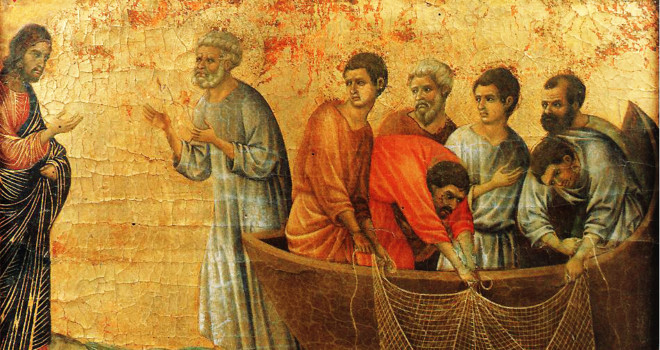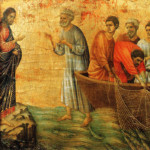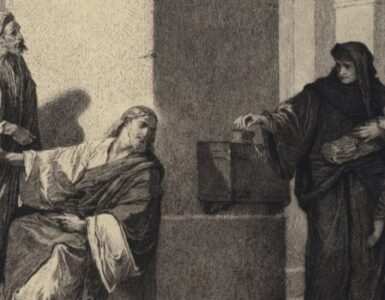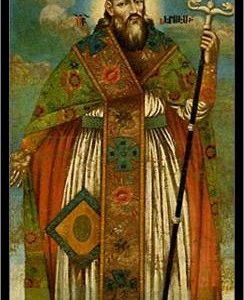In Sunday’s Gospel, Jesus appears to the apostles and says, “Peace be with you.” Why does this produce the exact opposite of peace?
Gospel (Read Lk 24:35-48)
We would do well today to keep the context of our Gospel reading in mind if we want to understand its full force. In the preceding verses, Jesus meets two disciples on Resurrection Day walking away from Jerusalem toward a town called Emmaus. They were bitterly disappointed in Jesus’ death. Seeing Him would certainly have cured that; however, they were “kept” from recognizing Him. That made it possible for Jesus to give them an extended Scripture lesson, showing them how God’s plan included the suffering and death of His Servant, Jesus. Still, the disciples did not know the identity of this Stranger. When they invited Him to stay with them, “He took bread and blessed and broke it, and gave it to them” (Lk 24:30). These were His exact actions at the Last Supper, too. At this, “their eyes were opened and they recognized Him; and He vanished out of their sight” (Lk 24:31). This remarkable event caused the excited disciples to hurry back to Jerusalem; we now take up the rest of the story.
While the disciples “recounted what had taken place on the way, and how Jesus was made known to them in the breaking of the bread,” He “appears in their midst.” His first word is “Peace,” but they were “startled and terrified and thought that they were seeing a ghost.” These strong words help us realize how stunning, disturbing, and otherworldly the Resurrection was for the apostles. There was simply no frame of reference for this; nothing like this had ever happened in human history. No wonder the appearances of Jesus did not exactly produce peace! The men were at a complete loss to cope with what was happening to them. Jesus begins to reassure them: “Look at My hands and My feet, that it is I Myself.” He directs their attention to His wounds, the most easily recognizable marks of His identity. Yes, it really is the same Jesus who was put to death and laid, stone cold, in a tomb. “They were incredulous for joy.” This was too good to be true. Can we imagine the questions that arose in their hearts? “Am I losing my mind? Is this a cruel joke? Has the food been drugged?” Reading their hearts, Jesus asks for food and eats it “in front of them.” Clearly this is done to prove beyond any doubt that although He had miraculously appeared in the room out of thin air, something humans cannot do, He ate food in a completely human way. What were they to make of this?
Knowing that His apostles were grappling with a profound mystery, one that was way beyond the bounds of reason, Jesus reminds them that He had spoken often about what was happening. His words, however, had only been words to them. There was no way for men to comprehend something that had never occurred within reality before. So, Jesus “opened their minds to understand the Scriptures.” Why did He do this? As Jews, the apostles believed the Scriptures to be God’s own revelation of Himself (just as we Catholics do, too). Even though they knew the words of Scripture through constant usage in Jewish liturgical life, they did not fully understand their meaning. Nobody did! They could only be fully understood in light of the work Jesus came to do. Having accomplished that, Jesus now shows them, by the gift of truth, that everything had happened exactly according to God’s plan. It was always God’s intention to stun His people with a miracle far exceeding man’s imagination, with a reversal of cosmic proportions.
Shouldn’t we pause here to realize that this is still happening for us as well? The Real Presence of Jesus in the Eucharist is just as bizarre, impossible, and otherworldly as His miraculous appearances on Resurrection Day. We, too, have trouble taking it in. At every Mass, there ought to be for us that “incredulous for joy and amazed” moment, when the priest says, “Behold the Lamb of God, behold Him Who takes away the sins of the world.” In the Gospel, we see the apostles struggle to understand the unthinkable. Jesus had to teach them from the Old Testament Scriptures that it was so. In time, of course, they got it. Then they preached the Gospel “to all the nations,” and that Gospel contained within it the unimaginable wonder of Jesus making Himself present in our midst in the Bread and Wine of communion. We might ask ourselves, “Can this be? Am I crazy?” The Church, in response, opens to us the New Testament Scriptures, and, by a charism of truth from the Holy Spirit, shows us what Jesus meant when He said, at the Last Supper, “This is My Body…this is My Blood.” The mysterious presence of Jesus in the Eucharist was always meant to be.
Returning to the Gospel, we see that the miracle of Jesus’ victory over death had a purpose. It was not simply to vindicate Him as God’s own Son. No, it was to make repentance and forgiveness of sin possible for all mankind. It was an event within history that was meant to change history forever. The point of the Gospel, then and now and until Jesus returns, is to turn the world upside down by turning hearts inside out. Did it work?
Our other readings continue the story…
Possible response: Lord Jesus, I understand that being baffled sometimes by the Eucharist at Mass is nothing unusual. Please turn it joy and away from doubt.
First Reading (Read Acts 3:13-15, 17-19)
On the Day of Pentecost, the apostles began their work of being “witnesses” to the Resurrection and of preaching repentance and forgiveness in the Name of Jesus. See how Peter reaches all the way back in Israel’s history to Abraham to explain how God fulfilled His plan to glorify “His Servant, Jesus.” This way of teaching reflects the Scripture study Jesus conducted with His apostles between the Resurrection and the Ascension. They were now able to grasp the sweep of salvation history and place themselves and their knowledge of Jesus within it. Peter understood that Jesus had become the “Suffering Servant” foretold by Isaiah hundreds of years earlier.
Peter also understood the purpose for which Jesus was willing to suffer and die: forgiveness. Look at his indictment of his audience. They had “handed over and denied in Pilate’s presence” the Servant God had sent them. They “asked for a murderer to be released” to them instead of the innocent Jesus. Summing up the charges, Peter uses some of the most painfully poignant words ever uttered to describe what God’s own people did to Him in the Crucifixion: “The Author of life you put to death.” Could there any offense committed in human history greater than this? Yet, that act of consummate evil was not the last word in man’s rebellion against God. In another stunning reversal, God “raised [Jesus] from the dead.” Now, repentance, conversion, and forgiveness can be preached to the very ones by whom Jesus was put to death. The enormity of this moment cannot be exaggerated. The miracle of the Resurrection makes possible the miracle of this kind of forgiveness, a miracle that can turn hearts inside out.
Yes, the Gospel is working!
Possible Response: Lord Jesus, I am sure I do not understand the depth of Your mercy to sinners like me, but I thank You for it with all my heart.
Psalm (Read Ps 4:2, 4, 7-9)
The psalmist gives us words to ponder in this season of Easter: “Know that the Lord does wonders for His faithful one; the Lord will hear me when I call upon Him.” These words refer first to Jesus, who is “His faithful one.” The “wonder” God did for Him was to raise Him from the dead. Because Jesus freely offered His obedience unto death for us, we, too, are included in those who can confidently ask: “O, Lord, let the light of Your countenance shine upon me!” At every Mass, God answers this prayer in the Eucharist. He grants the “wonder” of seeing Jesus, alive and well, in the Bread and Wine. Today, we sing, “Lord, let Your face shine on us.” Today, we know He will do this and put “gladness into [our] heart[s].”
Possible response: The psalm is, itself, a response to our other readings. Read it again prayerfully to make it your own.
Second Reading (Read 1 Jn 2:1-5a)
In the epistle, as is often the case, we have an opportunity to see how the events described in the Gospel work out in real life. How does the offer of repentance, conversion, and forgiveness that Jesus made possible and that the apostles preached turn the world upside down by turning hearts inside out? St. John explains it.
“My children, I am writing this to you so that you may not commit sin,” St. John tells us. Jesus’ victory over death was His victory over sin. We were not designed for sin but for goodness. When we sin, we are out of sync, off kilter, missing the point of our existence. This is what Jesus taught us, and this why He died for us—because we are weak, made of dust, and we do sin. Repentance and conversion mean we recognize this about ourselves. We are willing to become small before God, to cast ourselves on His mercy. We believe that Jesus is our “Advocate with the Father” and that He is “expiation [or atonement] for our sins.” However, this is not simply an intellectual assent to facts about Jesus. As St. John writes, “Those who say, ‘I know Him,’ but do not keep His commandments are liars, and the truth is not in them.” So, our trust in the work Jesus did for us, together with our willingness now to do the work for Him He gave us, will change man’s story on earth. How? In Jesus, we now become who we were always meant to be—the image and likeness of God. In a dark, confused world, “the love of God is truly perfected in [us].”
Friends, as St. John says elsewhere in this epistle (see 1 Jn 5:4), this is the victory that overcomes the world—our faith. Alleluia!
Possible response: Lord Jesus, I need your gracious help to keep Your commandments. I’m often tempted to talk about You without obeying You.












